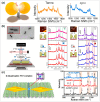Single-Molecule Detection of Optical Signals Using DNA-Based Plasmonic Nanostructures
- PMID: 40710048
- PMCID: PMC12292879
- DOI: 10.3390/bios15070398
Single-Molecule Detection of Optical Signals Using DNA-Based Plasmonic Nanostructures
Abstract
Single-molecule optical signal detection provides high sensitivity and specificity for the detection of biomolecules and chemical substances, which is of significant importance in fields such as biomedicine, environmental monitoring, and materials science. In recent years, DNA-based plasmonic nanostructures have emerged as powerful tools for achieving single-molecule optical signal detection due to their unique self-assembly properties and excellent optical performance. In particular, DNA origami technology enables the precise construction of metallic nanostructures with specific shapes and functions, which can effectively enhance the interaction between light and matter, thereby significantly increasing signal intensity and detection sensitivity. Furthermore, the programmability of DNA not only simplifies the implementation of single-molecule operations but also allows researchers to design and optimize nanostructures according to specific detection requirements. This review will explore the applications of DNA-based plasmonic nanostructures in single-molecule optical signal detection, including surface-enhanced Raman spectroscopy and enhanced fluorescence for single-molecule signal detection. We will analyze their working principles, advantages, current research progress, and future research directions. By summarizing the work in this field, we hope to provide references and insights for researchers, contributing to the advancement of biomedicine and environmental monitoring.
Keywords: DNA nanotechnology; enhanced fluorescence; plasmonic nanostructures; single-molecule; surface-enhanced Raman spectroscopy.
Conflict of interest statement
The authors declare no conflicts of interest.
Figures





Similar articles
-
Large-Area Nanogap Platforms for Surface-Enhanced Raman Spectroscopy Toward Sensing Applications: Comparison Between Ag and Au.Biosensors (Basel). 2025 Jun 9;15(6):369. doi: 10.3390/bios15060369. Biosensors (Basel). 2025. PMID: 40558451 Free PMC article.
-
Recent advances in the design of SERS substrates and sensing systems for (bio)sensing applications: Systems from single cell to single molecule detection.F1000Res. 2025 Jun 24;13:670. doi: 10.12688/f1000research.149263.3. eCollection 2024. F1000Res. 2025. PMID: 40255478 Free PMC article. Review.
-
Supercharged DNA origami enhanced signal amplification for ultrasensitive detection of nucleic acid.Biosens Bioelectron. 2025 Nov 1;287:117692. doi: 10.1016/j.bios.2025.117692. Epub 2025 Jun 13. Biosens Bioelectron. 2025. PMID: 40517661
-
Short-Term Memory Impairment.2024 Jun 8. In: StatPearls [Internet]. Treasure Island (FL): StatPearls Publishing; 2025 Jan–. 2024 Jun 8. In: StatPearls [Internet]. Treasure Island (FL): StatPearls Publishing; 2025 Jan–. PMID: 31424720 Free Books & Documents.
-
Management of urinary stones by experts in stone disease (ESD 2025).Arch Ital Urol Androl. 2025 Jun 30;97(2):14085. doi: 10.4081/aiua.2025.14085. Epub 2025 Jun 30. Arch Ital Urol Androl. 2025. PMID: 40583613 Review.
References
-
- Tang C., Huang L., Sangtarash S., Noori M., Sadeghi H., Xia H., Hong W. Reversible switching between destructive and constructive quantum interference using atomically precise chemical gating of single-molecule junctions. J. Am. Chem. Soc. 2021;143:9385–9392. doi: 10.1021/jacs.1c00928. - DOI - PubMed
Publication types
MeSH terms
Substances
Grants and funding
LinkOut - more resources
Full Text Sources

